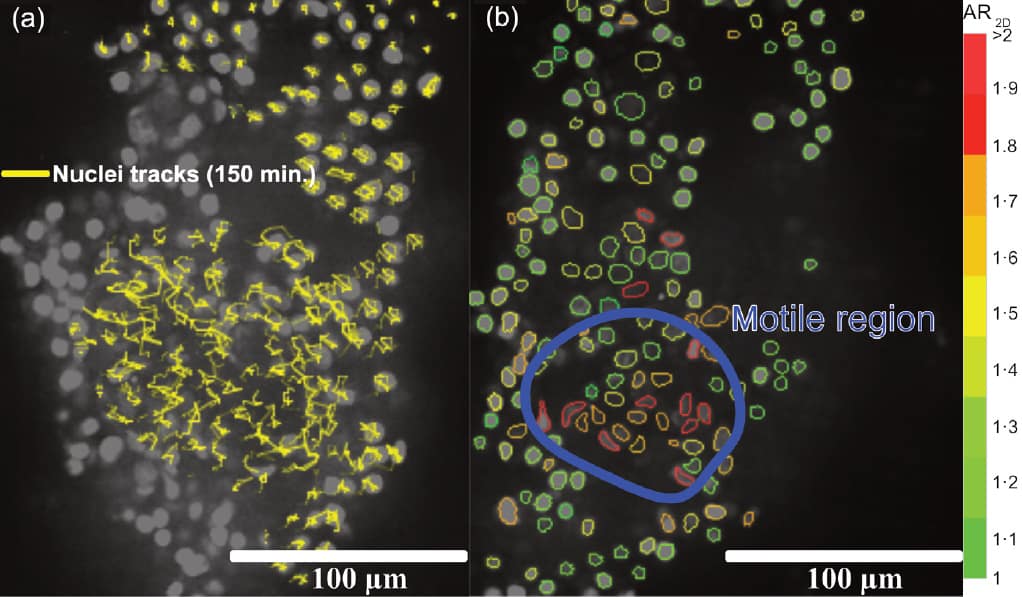
The physical concept of jamming – originally developed to understand the behaviour of glasses and granules – could improve predictions of whether cancers are likely to spread.
Research carried out by doctoral student Pablo Gottheil and colleagues from the Soft Matter Physics Division of Leipzig University has shown that the prognostic accuracy for cancerous tumours spreading increases by 26% when the detection of cancer cell unjamming is employed alongside existing prognostic methods.
Cancers spread when cells from a primary tumour travel through the body via the bloodstream or lymphatic system, then seed further tumours known as metastases. This involves cells that were packed together in the primary tumour becoming mobile, in a similar manner to the state transition between jammed solid-like and unjammed liquid-like behaviour within amorphous materials and granules: when unjammed, particles can flow like table salt onto your dinner, but being jammed is akin to the salt flow stopping when it gets into a configuration that blocks the tiny salt cellar hole.
Since living human cells within closely packed cell aggregates and tissues exhibit similar jamming and unjamming, similar concepts can be used to study the process. “To understand cancer you can’t just look at the genome, you also have to look at physics,” says Josef Käs, head of the research team and Gottheil’s PhD supervisor. “Metastasis has emergent collective effects which can be described by mechanics and soft-matter physics.”
In a first clinical study, reported in Physical Review X, the researchers analysed clinical data and histological samples from 1380 patients with breast cancer. Unlike previous work by other groups that characterized cell unjamming in terms of either the cell’s shape or its density, the Leipzig researchers reconciled this conflict by taking shape and nucleus packing into consideration.
Their research quickly confirmed that both cell and nucleus shape, as well as nucleus number density were involved: specifically, when a tumour is unjamming, its cells and nuclei elongate and the cell nuclei are more loosely packed. This enables the cells to move more readily than when they are rounder, as it is easier for them to squeeze between other cells and exchange places with them. Furthermore, the team found that an increased prediction of unjamming occurring for a given tumour correlated well with the actual development of secondary cancer in that patient any time up to a decade later.
The researchers represented the cancer cell and nucleus shape, and the cell area as a measure of nuclei packing, in a comprehensive state diagram of cancer cell unjamming that indicates patients at high and low risk of developing metastases. This simple diagram could be used to assess prognoses in 92% of cancers.
“It is intriguing that the static geometric signature of the primary tumour cells can serve as a proxy for cell motility, which then actually correlates with tumour progression,” Gottheil tells Physics World. “Established markers, such as the status of affected lymph nodes, already show that cancer cells left the primary tumour, whereas our marker predicts that if classified as motile and unjammed, the tumour should have a higher likelihood of distant metastasis formation.”

Cell softening allows cancer cells in rigid tumours to spread
“Currently one of the biggest problems in all cancers is over- and under-treatment because we don’t have a precise prognosis in cancer diagnosis,” adds Käs. He hopes that their technique – which can be applied to histological samples already routinely collected – could reduce that problem. His team will shortly embark on a retrospective clinical trial working with 25,000 breast cancer patients and Pathology Hamburg-West, and strive to establish prospective multi-centre clinical trials for breast and colon cancer.
Käs intends keeping the work in the public domain so as many patients as possible can benefit. “It is so horrible for people not knowing from one year to the next if their cancer will relapse. Anything I can do to alleviate that situation makes me happy,” he says.



